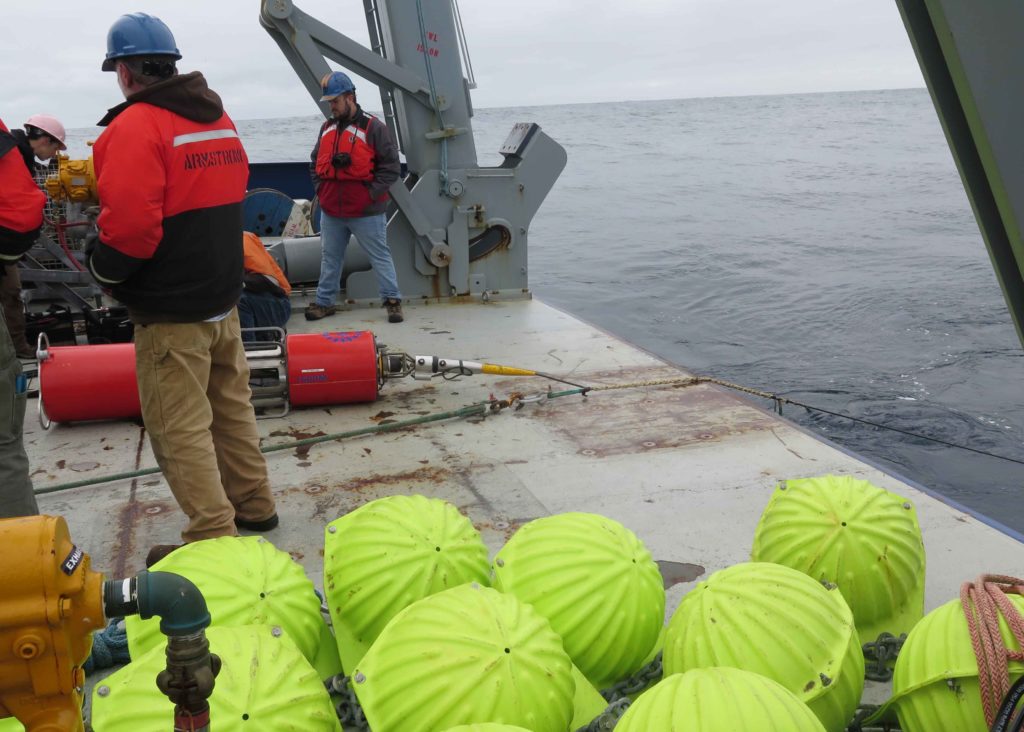by Heather Furey
Friday, June 15th.
Men’s World Cup on the ship’s satellite television? Must be OSNAP time.
It is still gray and cool outside, approx. 4C and 40F. But the rain is gone. I saw the sun reflecting off the ocean surface in a break in the clouds once this morning, the ocean surface is dark silver. Not the sun itself, just a derivative of the sun. I’ll take it. I have never been in the Irminger Sea this close to the southern tip of Greenland before; the ocean here seems more unpredictable than the Iceland Sea, where I have spent my last three OSNAP cruises. Just an impression – it seems like you need to watch your back out here. Water has been flat so far, though. So far.
We deployed our first OSNAP mooring yesterday: M4, the farthest offshore mooring which just captures the outer edge of the DWBC off the east coast of Greenland. This is the second mooring I have had the satisfaction of deploying, and it is a great pleasure seeing a mooring put in the water in a calm, controlled, effective manner. One technique used by this mooring team is the use of a YaleGrip to transfer line tension or load off a partially payed out mooring line. A person might need to do this to move a wire from one winch to another, or to take tension off a wire to attach and inline instrument where the wire termination is not favorable to secondary shackles – let’s say at the end of an electrical-mechanical (EM) cable. I have never seen them used by any other mooring deployment group; it is possible I had not paid careful attention on previous cruises.

A YaleGrip in the rigging van. The one pictured is the smallest we have out here, and is for the thinnest wire mooring cables. The color coding at the ends indicated the strength of the grip.
Yale grips work like ‘finger traps’, the children’s toy made of woven strips of paper overlapped into a finger-sized tube. Put a finger in each side, and try to pull them out … stuck!
The grips are each a set of four Kevlar flat ropes that are wrapped around a taught wire. The grip begins with a loop (that can be later attached to a cleat or tie-off) secured in place with electrician’s tape. The loop end is located at the inboard end of the mooring wire, and the grip reaches toward the overboard end of the wire. Once the loop end is secured, the tension can then be slowly released from the original wire safely.

A YaleGrip being used to transfer tension off the termination of an EM cable so that the inline instrument can be attached.
This may sound dry in text, but to see it done in action is not. Once the loop of the YaleGrip is taped in place, two people send 1-2 meter lengths flying through the air in great arcs as the grip is put in place, wrapped around the mooring wire. It is an interesting contrast to see the highest of technical moorings still at the mercy of the old craft. As Jim Dunn puts it, “if you had a tug of war, the YaleGrip would win.” I just like the on-the-fly old school nature of the load transfer; it has a certain beauty to it.
Putting on the grip.
Johannes Karstensen and Penny Holliday, on the MSMerian, are on the east side of Greenland now, and the plan (at least as of 15:00 on 15 June 2018) is for the Merian crew to recover OSNAP moorings M1, 2, and 3 tomorrow. And we will follow in their wake on the 17th to begin deploying mooring in the same locations.
